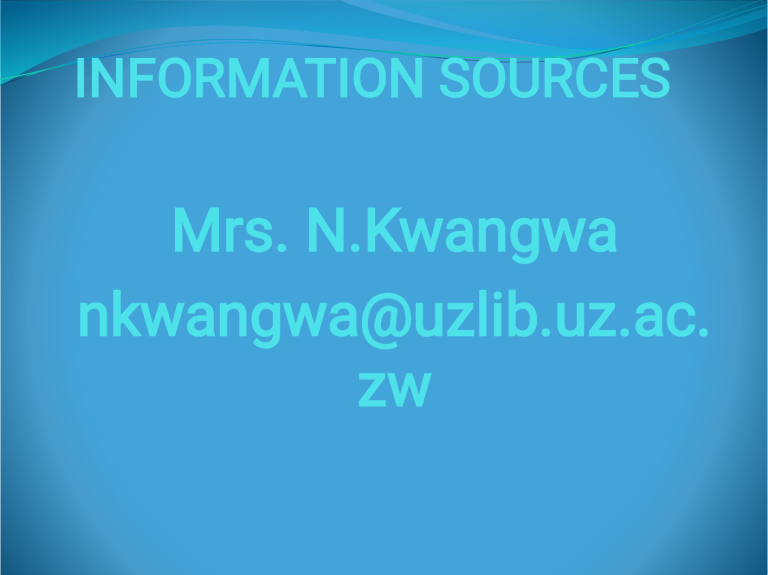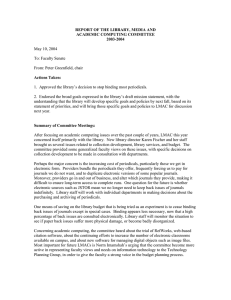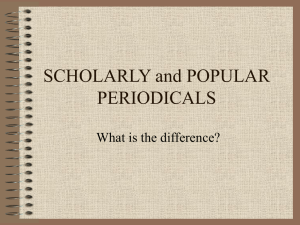
INFORMATION SOURCES Mrs. N.Kwangwa nkwangwa@uzlib.uz.ac. zw Information Sources Learning Objectives Students should learn: The definition of information sources Major producers of Information Sources Types of Information Sources Internet Information Sources Information Sources-Definition An information source is where you got your information from; this can be a book or a Website Information sources are the various means by which information is recorded for use by an individual or an organisation Information can come from virtually anywhere: personal experiences, books, articles, expert opinions, encyclopedias, the Web. The important thing is to choose sources that give credence, authority and support to your work. Major producers of information There are three main producers of information. These are I. Government Agencies (Judiciary Services Commission, Ministry of Justice, Legal and Parliamentary Affairs ) II. Academic institutions (UZ) III. The private Sector (UNICEF) IV. Professional Associations-Law Society of Zimbabwe V. Individuals (University Professors) Types of Information Sources Primary-These are original materials on which other research studies are based. Secondary-created by someone who did not have firsthand experience or did not participate in the events or conditions being researched They are interpretations and evaluations of primary sources written significantly after events by parties not directly involved but who have special expertise. Tertiary-consist of information which is a distillation and collection of primary and secondary sources They are twice removed from the original source and their main purpose is to list, summarise or simply repackage ideas or other information. Categories of Information Sources There are various categories of information sources and different assignments require information from a variety of sources. The selection of information sources to be used is largely determined by the information needs and requirements. Information sources can be categorised into books, periodicals, reference sources, databases, portals, subject gateways , archives/institutional repository Books These are works written on widely varying themes and they cover virtually any topic, fact or fiction They are written by researchers or experts and are only published after passing through editors or publishers Books can be in print or electronic (e-books). Useful for the complete background on an issue or an in-depth analysis of a theory or person Can take years to publish, so may not always include the most current information Periodicals These are publications published on a regular basis - daily, weekly, bi-weekly, monthly, bimonthly, quarterly or yearly. The information in periodicals covers a wide variety of topics and is very up-to-date. Periodicals are available in both print and electronic formats. Common examples of periodicals include popular magazines (or general interest magazines), professional and trade magazines, scholarly journals, newsletters, and newspapers. Journals Include articles written by and for specialists/experts in a particular field Articles undergo a peer review process before they're accepted for publication Articles tend to have a narrower focus and more analysis of the topic than those in other types of publications Journals are written by experts or specialists in a particular field/discipline and targeted towards other scholars. The articles are usually longer and may contain charts, graphs and statistics as well as extensive bibliographies. The articles usually involve extensive research and in-depth studies. The writing style is more complex and the language may be technical. Cont’ Examples of this type of periodical are academic journals and professional journals. Academic journals are written by members of an academic community and are reviewed by their peers while professional journals are written by members of a professional body including Geologists, GIS Specialists, Mathematicians,, lawyers, doctors and engineers Examples of journals include: Journal of Environmental technology Cont’ Zimbabwe Law Journal Law and Policy Journal of African Law The Journal of Legal Studies Industrial law Journal Reference Sources These are authoritative works that provide specific answers or information. There are many types of reference sources, including atlases, dictionaries, encyclopedias, thesauri, almanacs, manuals, biographies, and handbooks, bibliographies, indexes and abstracts among others. Reference information sources can be general or subject specific. For example, The Encyclopedia Britannica is general while Encyclopedia of Law and Society Cont’ Abstracts An abstract is a brief synopsis or summary of the most important points that the author makes in the paper. It is a highly condensed version of the paper itself. After reading the abstract, the reader knows the main points that the authors have to make. Indexes Indexes are a finding guide to the contents of particular journals. They provide subject, author, and/or title indexing to a particular set of periodicals and give a full citation for each article. Cont’ Bibliographies These are publications that consist of a list of books, articles and other works on a particular topic. Sometimes bibliographies are annotated, that is they include brief abstracts summarising the important features of the works. Databases A database is a collection of information in electronic form that is organised in a manner that allows a user to easily retrieve information about its individual entries. The content of databases has undergone a review process and the information is more reliable than information found on the Internet Cont’ Examples of databases include: Taylor and Francis, Emerald Publishing Group, JSTOR, Wiley Online Library, etc Institutional Repositories/ Archives It consist of formally organised and managed collection of digital content generated by faculty, staff and in some cases by students. An example of on institutional repository is the UZ Institutional repository http://ir.uz.ac.zw Stanford University Repository, Loughborough University’s Institutional repository Sources of Legal Information Annotations Cases Statutes Judgements Administrative Laws Treaties Activity 1. Given a journal article and magazine which one will you use when writing an assignment? Give reasons 2. Identify and briefly explain information sources available in the UZ Library 3. Identify and describe the sources of legal information provided on this website: https://zimlii. org/content/welcome-zimbabwe-legal-informationinstitute-website-0

